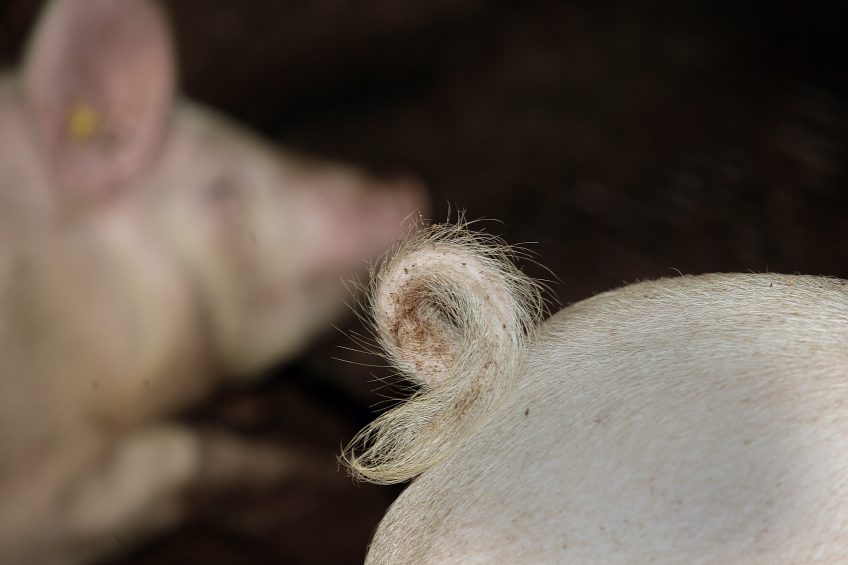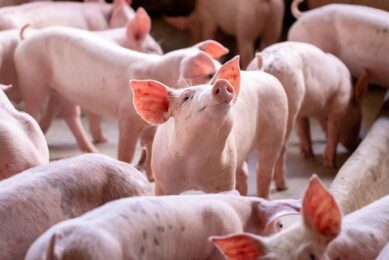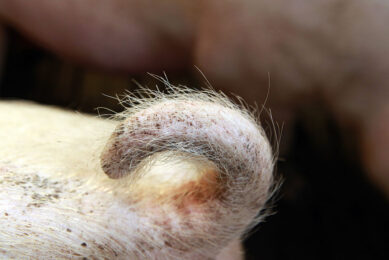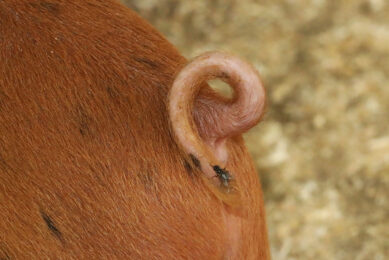Poor health as a risk factor for tail biting

In several episodes, leading welfare researchers explain the results they obtained within the international framework ‘FareWellDock’. This project investigates how to steer away from tail docking. Norwegian and Finnish researchers dived into the topic of health and tail biting – are these phenomena interrelated?
Tail biting is detrimental to animal welfare and has a negative impact on producer economy. We know that tail biting is a multifactorial problem with nutrition, feeding routines, pen design, pig density and the availability of manipulable material all influencing the net risk of a tail biting outbreak. Poor health has also been considered an important risk factor, but with less supporting evidence.
Newer research within the EU collaborative project FareWellDock supports earlier findings and anecdotal reports that health does indeed influence the behaviour of pigs, and provides new knowledge about possible mechanisms.
Up to now, the evidence pointing towards sickness increasing the likelihood of tail biting outbreaks has come from expert opinion and experience, epidemiological studies, case control studies and clinical reports. Farms with health problems are considered to have a higher risk of a tail biting outbreak and the risk of tail biting damage on farms with rectal prolapse and respiratory disease has been found to be increased.
Clinical reports have stated that deworming and vaccination against Lawsonia intracellularis reduced tail biting while both leg disorders and respiratory inflammation were highly correlated with tail damage. These reports clearly show that there is an association between sickness and tail biting, but because tail biting may also lead to inflammation due to bacteria entering the wound, it is difficult to know what came first: poor health or a damaged tail. The issue is also further complicated by the fact that some risk factors for tail biting may also influence health.
In the project FareWellDock a team of researchers from Norway and Finland have worked to increase our understanding of the links between health and tail biting, both by investigating the association between health status and tail biting, and by studying the mechanisms by which health can influence behaviour.
Influencing behaviour through immune system
One possible way for health to influence behaviour is through the immune system. When the body receives an infectious or even non-infectious insult, the immune system is activated and produces cytokines. These small proteins reach the brain and induce sickness behaviour: the set of behavioural changes we all know from suffering from bad colds or influenza such as lethargy, loss of appetite and thirst, social withdrawal, reduced interest in the surroundings and even depression or irritability.
From the description of sickness behaviour and from the side effects experienced by humans treated with cytokines as a part of cancer or hepatitis treatment, it is known that cytokines may have a strong influence on mood. Cytokine-treated patients have reported increased emotional ability, tearfulness, depression and irritability.
Humans experiencing mood changes brought about by cytokines, such as irritability during influenza, may choose to isolate themselves and thus decrease the chance of negative interactions with others. Pigs in commercial housing cannot withdraw in this way and illness may affect social interactions within a pen in a way that increases the likelihood of tail biting, either by making a pig more likely to become a victim or a biter. Victimisation may happen to a pig that is lethargic. It may be targeted as a victim by the others. Others may also prefer to compete with this pig for resources as they are more likely to win. This could lead to the sick pig being bitten and bullied at the feeder.
On the other hand, a pig that is not ill enough to be lethargic may be irritable and tend to bite other pigs more easily. To look further into these two possible scenarios, the team undertook a field study published this year in Physiology & Behavior.
As this was a study on spontaneously occurring illnesses on a non-experimental farm, the team ended up with very little actual tail biting. The team therefore looked at all social behaviours including sniffing at and biting of tails and collected behavioural data, health data, feeding data and blood samples from undocked boars at a test station farm in Norway.
Groups with three different diagnoses were compared with healthy controls (Ctr).:
1. Osteochondrosis diagnosed by computer tomography scanning (Ocscan);
2. Osteochondrosis diagnosed by clinical examination (Occlin); and
3. Respiratory tract disease (Resp),
Social behaviour and cytokine levels
The team tested whether the diagnoses were associated with social behaviour and cytokine levels; the team then tested whether there were correlations between cytokine levels and social behaviour. Social behaviour differed between experimental groups with Ocscan pigs receiving more social behaviour (both aggressive and non-aggressive) compared to Ctr, and Resp pigs tending to perform more ear- and tail-biting than controls.
There were no differences in absolute levels of cytokines between categories, but this is most likely because the team was not able to sample during the acute phase of illness. However, one anti-inflammatory cytokine (IL1-ra) and one pro-inflammatory cytokine (IL-12) showed correlations with several behaviours that have been shown by others to be associated with current or future tail biting activity.
Pigs with high levels of IL-12 were attacked more in the pen, and also received more sniffing towards their body and tail at the feeder. This finding supports the hypothesis that immune activation can influence social behaviour with close links to tail biting. The results also indicate that the type of and stage of illness will influence whether a pig is more likely to end up a victim or a biter.

Controlled experiments
In order to look further into how cytokine levels change in response to immune activation, and to link that to specific behavioural changes, the team carried out two controlled experiments.
Using this methodology the team could time the immune stimulation exactly, and if behaviours were observed that only appeared in the inflammatory group, that would support the hypothesis that ill health actually causes this behaviour. In both experiments, the team used a component of the cell wall from E. coli (lipopolysaccharide; LPS) to stimulate the immune system of the pigs. In the first experiment, pigs were surgically fitted with permanent central venous catheters and housed individually. Thus, repeated blood samples could be taken without stressing the pigs.
The pigs were euthanised 72 hours after LPS injection and the research team also took brain samples for analysis. While all blood parameters were back to normal after three days, it was found that brain values were not. The pigs that were injected with LPS had higher levels of a cytokine called IFN-gamma in their frontal cortex compared with control pigs. This cytokine is important, because it can influence the neurotransmittor balance in the brain. In a follow-up experiment the team kept pigs in groups of three and gave one pig per pen LPS while her two pen mates got saline. The team did not take any blood samples, but looked at social behaviour only.
Interestingly, 73-80 hours after injection, corresponding to the timing of brain samples in the previous experiment, the LPS-treated pigs increased their tail-and ear directed behaviour. The control (saline-treated) pigs directed more social behaviour of all kinds towards the LPS-treated pig than towards the other control pigs.
Pigs injected with lipopolysaccharide
When the team looked at these three studies together it seems that pigs injected with LPS are a bit irritable after being ill, and other pigs perceive them as different from control pigs. Furthermore, the field study shows that cytokine levels correlate with several categories of social behaviour.
This indicated that immune activation influences social behaviour in a way that can increase the risk of tail biting, even when the pigs do not show any overt clinical signs of illness anymore. These findings will be followed up with further studies.
Parts of these future studies will aim to test whether it is possible to prevent the adverse changes in social behaviour by blocking the immune response. As of now, the evidence indicates that keeping pigs healthy is good not only from a classical preventative medicine perspective, but also lowers the risk of a tail biting outbreak.
References available on request
* The article was co-authored by Andrew M. Janczak, also associated with the Norwegian University of Life Science in Oslo, Norway; as well as by Camilla Munsterhjelm, Mari Heinonen and Anna Valros, University of Helsinki, Finland.
Join 18,000+ subscribers
Subscribe to our newsletter to stay updated about all the need-to-know content in the pigsector, three times a week. Beheer
Beheer










 WP Admin
WP Admin  Bewerk bericht
Bewerk bericht